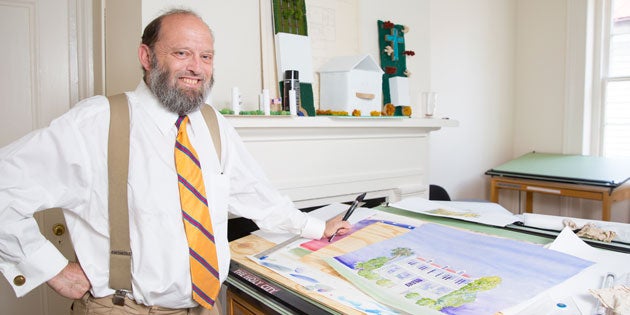If you’ve kept a sharp lookout when wandering the streets of Charleston these last few weeks, you may have noticed a few homes around town decorated with diamonds.

Notecards bearing Ralph Muldrow’s watercolors of the Porgy Houses will be sold to promote the preservation of African-American culture in Charleston.
No, the homes have not become jewel encrusted, but rather have received an application of diamond-shaped stickers. The addition of the diamonds, meant to evoke a West African motif, coincide with the opening of the George Gershwin opera “Porgy and Bess” during Spoleto Festival USA 2016 and are intended to draw attention to 10 buildings with strong ties to African American history in Charleston. The diamonds were applied at the behest of renowned artist Jonathan Green, the visual designer for “Porgy and Bess.”
To help commemorate these buildings and their temporary change in appearance, Associate Professor of Art and Architectural History Ralph Muldrow has painted watercolors (which were then digitally enhanced by Sally Caithness Walker) of the assorted structures as part of a collaboration between Spoleto Festival USA, the College of Charleston Historic Preservation and Community Planning Program, and The Preservation Society of Charleston. Muldrow’s paintings of the so-called “Porgy Houses” showcase buildings that belonged to some of Charleston’s pioneering black professionals, including the homes of a prominent black builder, a black teacher, a caterer and a doctor. The home (and now museum) of the late blacksmith Philip Simmons is among the buildings featured, as well as the home of chef/author Nathalie Dupree and Jack Bass, a white journalist who has written extensively on race relations in the South. Bass is also a professor emeritus of humanities and social sciences at the College.
For Muldrow, who had worked for years as a full-time architect before cofounding the College’s Historic Preservation and Community Planning Program and becoming the Simons Chair Professor of Architecture and Preservation, watercolor painting is a labor of love. He begins by sketching a building with pencil, then soaks his sketch paper in a tub for three hours before stapling it to plywood and letting it dry overnight. With the dried paper then able to better absorb water and pigment without becoming distorted, Muldrow colors his drawings, in this case tinting windows, siding, roofs and other exterior features of a home. Muldrow says he took particular pleasure in the freedom that foliage enabled him, as he did not need to stay within any lines when freehand drawing the landscaping surrounding a structure.
Bricks are more tedious to paint than clapboard siding, Muldrow reports, and the empty skies above each home surprisingly intimidating to create. Applying a wide brush dipped in purple or blue to the top of his paper, Muldrow says he had to “take a deep breath and just go for it. There’s nothing else you can do.” Then, voila! A sky was born.
Muldrow, who counts John Singer Sargent and William Merritt Chase among the artists who inspire him, first savored the medium of watercolors while an architecture student at the University of Pennsylvania under the tutelage of architect John Blatteau. After graduation, Muldrow worked as an architect in New Jersey, designing and restoring new and old libraries in New York City. Seeking a side job about that same time, circa 1987, he once answered a newspaper ad for an illustrator gig. Muldrow soon found himself creating set design renderings for artists like the Beastie Boys, Debbie Gibson and LL Cool J.
For LL Cool J, for example, he illustrated a set featuring an 8-foot-tall diamond ring with light bulbs that was supposed to house a drummer during an upcoming performance at the Meadowlands in New York. For the teen sensation Gibson, he illustrated a stage with a translucent floor. Gibson’s mother apparently had to approve it, Muldrow recalls, since her daughter was underage.
“One of those only-in-New-Jersey experiences,” Muldrow says of his stint as a rock n’ roll illustrator.
 Muldrow subsequently focused on his architecture career and young family before moving south and beginning his career at the College, where he also teaches preservation and architecture courses within the Graduate Program in Historic Preservation, which Muldrow also cofounded and which is administered by both the College and Clemson University.
Muldrow subsequently focused on his architecture career and young family before moving south and beginning his career at the College, where he also teaches preservation and architecture courses within the Graduate Program in Historic Preservation, which Muldrow also cofounded and which is administered by both the College and Clemson University.
This fall Muldrow will put away his watercolor brushes as he heads off on sabbatical to study the life and work of Thomas U. Walter, an American architect known for his additions to the U.S. Capitol. But even with his paintbrushes dry, Muldrow’s images of the “Porgy Houses” will live on, with Muldrow’s images having been printed on notecards and sold to benefit the Jonathan Green Fellowship, which supports a College of Charleston student committed to African-American heritage preservation and advocacy. The set of notecards sells for $25 and can be purchased at the Spoleto tent on Marion Square, the Gaillard Center, the Preservation Society‘s store at 147 King St., the Historic Preservation and Community Planning Program office at 12 Bull St., and other retailers around town.









